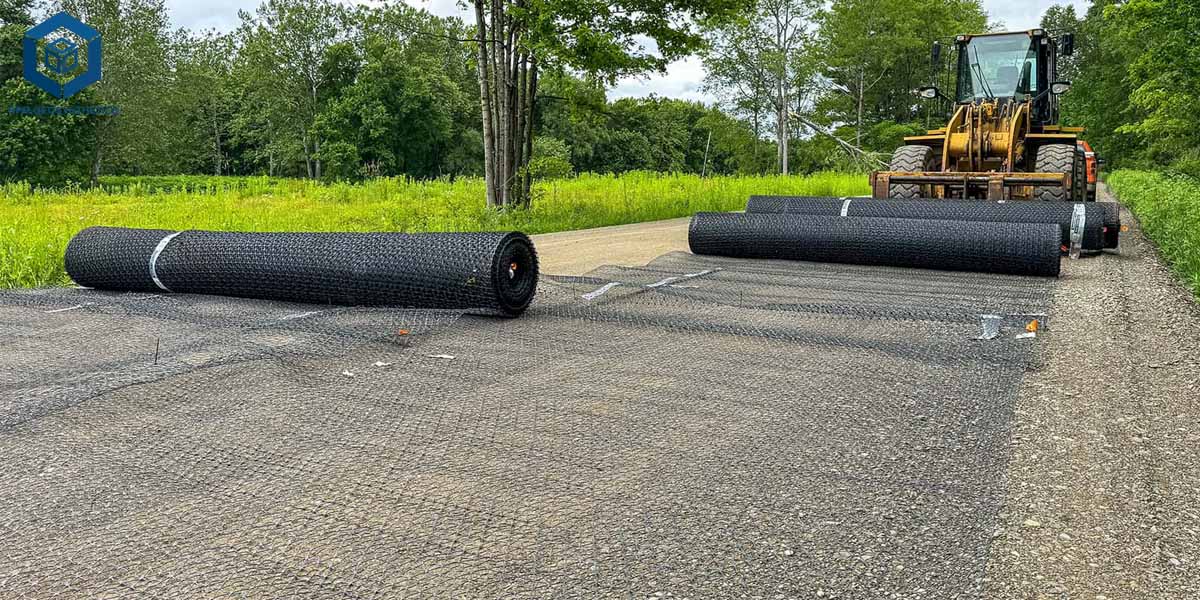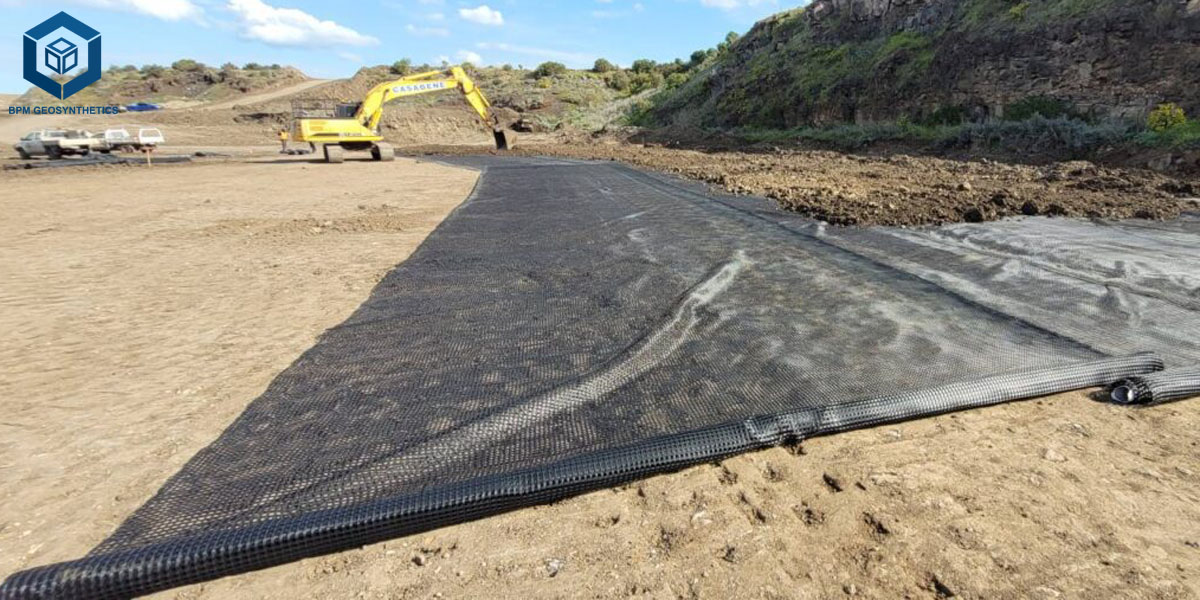How to Choose Right Geogrid for Road ?
Choosing the proper geogrid for road construction can make the distinction between a long-lasting, steady roadway and one plagued by way of cracks, rutting, and expensive repairs. With a vast range of materials, strengths, and designs available, deciding on the ideal geogrid may additionally appear overwhelming—but grasp the key elements can simplify the system and make certain your avenue performs reliably for years to come. In this guide, we’ll ruin down what you want to recognize to make an knowledgeable preference and optimize your pavement’s durability.
1. What is Geogrid for Road?
Geogrid is made of high molecular polymer after extruded and laminted and punched into regular mesh before longitudinal stretching , this process makes high molecule in direct line state in oblong oval net structure with uniform distribution and high node intensity . This structure has rather high tensile strength and stretch nodulus , especially our products of this kind have superior world class tensile strength and strech modulus with extensibility between 2% and 5% , the soil offers ideal force carrying and diffusing chain system , it has large tensile strength and is suitable for different kinds of soil .
2. How to Pick Right Geogrid for Road?
Geo grid mesh have revolutionized street development by using improving soil stability, lowering deformation, and extending the existence of infrastructure. Selecting the fine kind of geogrid requires a deep appreciation of project-specific factors, together with soil conditions, loading requirements, environmental challenges, and price range constraints.Key Factors Influencing Geogrid Mesh Selection:
2.1 Project Requirements and Soil Conditions
- Weak Subgrade Soils: Projects in areas with soft, unstable soils (e.g., silty clay or high-shrink-swell soils) demand geogrids with excessive tensile electricity to forestall settlement. For example, the NHAI task in Raebareli, India, used Ocean PP Geogrid-20Kn to stabilize silty clay soils, decreasing subsidence dangers .
- Heavy Traffic Loads: High-traffic roads, such as highways or industrial access routes, require geogrid driveway capable of distributing loads uniformly. The Tensar TriAx Geogrid (PP) was deployed in Pennsylvania to support 1,000 daily heavy vehicle trips on weak soils, improving load distribution and reducing aggregate requirements by 30% .
2.2 Geogrid for Road Mechanical Properties
- Uniaxial Geogrid: Ideal for slope reinforcement or retaining walls where stress is directional (e.g., Gongjian’s fiberglass geogrid for pavement cracking resistance) .
- Biaxial Geogrid: Equally strong in both directions, suitable for road base stabilization. The Ocean PP Biaxial Geogrid-30 kN in Zirakpur, Punjab, enhanced subgrade stability under semi-urban traffic .
- Triaxial Geogrid: Offer multi-directional stability for dynamic loads, as seen in the Tensar TX7 geo grid driveway project, which bridged saturated soils using a hexagonal rib design .
2.3 Environmental and Durability Considerations
- Chemical Resistance: Polypropylene (PP) geo grid ground grid withstand degradation from oils, salts, and UV exposure, making them best for harsh climates.
- Temperature Fluctuations: Fiberglass geo grid mesh excel in high-temperature environments, whilst polyester PET geogrid tolerate freezing prerequisites .
2.4 Evaluate Different Geogrid Material
- Plastic Geogrid : Usually made of polypropylene (PP) or excessive - density polyethylene (HDPE), they are lightweight, corrosion - resistant, and handy to construct. But they may additionally deform at excessive temperatures and have vulnerable UV resistance.
In this project, the high groundwater level might lead to relatively high humidity, and the plastic geogrid soil stabilization's anti - aging problem could be a concern.
- Glass Fiber Geogrid : Made of glass fiber yarns and coated with asphalt or other polymers, they have extremely high tensile strength, good high - temperature resistance, and chemical stability. However, they are brittle and have weak impact resistance. For the embankment construction in this project, the brittleness of glass fiber geogrid material might be a disadvantage during construction.
- Polyester (PET) Geogrid : Made of polyester fibers, they have high toughness and fatigue resistance, with excellent creep - resistance performance, which means they have little deformation under long - term load. This property is very suitable for the road embankment project that needs to bear long - term vehicle loads.
- Steel - Plastic Composite Geogrid : Combining the high strength of steel wires and the corrosion - resistance of plastic, they have extremely high tensile strength and are suitable for projects with extremely high strength requirements. But they are heavy and have complex construction processes, which may increase the construction cost and difficulty.
2.5 Geogrid for Road Installation and Cost Efficiency
- Ease of Handling: Lightweight geogrid slope stabilization reduce labor costs and installation time .
- Material Savings: Geogrid erosion control minimize aggregate usage by 20–40%, lowering project costs. For instance, the Pennsylvania project saved $1.2 million by replacing thick aggregate layers with a geo grid wall-reinforced system.
2.6 Geogrid for Road Design and Implementation Guidelines
- Soil Analysis: Conduct CBR (California Bearing Ratio) checks to decide the subgrade power and become aware of any vulnerable zones that may also require stabilization. Accurate soil evaluation helps in deciding on the splendid retaining wall grid kind and thickness for ideal performance.
- Geogrid Overlap: Follow IRC guidelines (e.g., 30–50 cm overlap for biaxial grids) to make sure acceptable load switch and non-stop reinforcement. Proper overlapping prevents separation beneath site visitors hundreds and enhances structural integrity.
- Aggregate Selection: Use well-graded substances (e.g., 16–30 mm overwhelmed stone) to beautify interlocking with the plastic geogrid and enhance common pavement stability. Choosing the proper combination additionally minimizes voids and reduces the threat of settlement.
- Compaction: Achieve at least 95% Proctor density to firmly lock the geogrid mesh retaining wall into the base layer, making sure long-term overall performance underneath site visitors loads. Well-compacted layers assist distribute hundreds evenly and prolong the pavement’s carrier life.
2.7 Performance Evaluation Metrics
- Field Testing: Use dynamic cone penetrometers to examine stiffness improvements. These exams assist quantify the reinforcement impact of the polyester geogrid on the subgrade and affirm that format specs are met.
- Longevity: Monitor cracking and rutting annually. Mechanistic-Empirical (M-E) fashions can predict 50+ yr overall performance for suitable set up retaining wall geo grid. Regular monitoring lets in well timed preservation and validates long-term pavement conduct beneath site visitors loads.
- Construction Process: During installation, the hdpe geogrid used to be laid in accordance to the exact procedures. Workers ensured that the laying floor used to be flat and free of sharp objects to stop injury to the geogrid. The lap width used to be managed to be no much less than 30 cm, and U-shaped nails have been used for fixing at intervals of 1–1.5 meters. Careful interest all through set up ensures uniform reinforcement and maximizes the structural advantages of the geogrid stabilization.
Up to now, the street embankment has proven right stability. The plastic geogrid mesh has successfully disbursed the load, decreased the agreement of the embankment, and resisted the lateral displacement of the soil, making sure the ordinary development and use of the motorway.
Summary
Choosing the right geogrid ensures optimal strength, durability, and suitability for any project, from soft soil stabilization to road repair. With over 20 years of experience, The Best Project Material Co., Ltd.(BPM Geosynthetics)specializes in high-quality geogrids and geosynthetics, certified by ISO9001, ISO14001, ISO45001, and tested by SGS and Intertek. Widely used in road construction, drainage, mining, and erosion control, BPM geogrid offer reliable performance, innovative solutions, and professional after-sales support, making them a trusted partner for long-lasting infrastructure.


